Chern-Simons Theory Coupled to Competing Scalars
Abstract
We study a spontaneously broken Chern-Simons-Higgs model coupled though a Higgs portal to an uncharged triplet scalar with a vacuum state competing with the Higgs one. We find vortex-like solutions to the field equations in different parameter space regions. Depending on the scalar coupling constants we find a parameter region in which the competing order creates a halo about the Chern-Simons-Higgs vortex core, together with two other regions, one where no vortex solutions exist, the other where ordinary Chern-Simons-Higgs vortices can be found. We derive the low-energy theory for the moduli fields on the vortex world sheet and also discuss the connection of our results with those found in studies of competing orders in high temperature superconductors.
1 Introduction
Among the many applications of vortex-like solutions in gauge theories there has been renewed interest in the study of models in which there are two scalars with different ground states, a subject which is relevant both in high energy and condensed matter physics.
In high energy physics, the existence of a charged scalar with a nontrivial vacuum expectation value in the core of a vortex can lead to striking effects originally signaled in [1] in the context of superconducting strings. Also (center) vortices are relevant to the study of confinement (see [2]- [3] and references therein for more recent results) and in the effective descriptions in the case of space-time where the Chern-Simons term plays a central role [4]. There have also been recent and interesting applications in the construction of low-energy Lagrangians in the world-sheet of the Abrikosov-Nielsen-Olesen string by the addition of an extra non-Abelian moduli field [5]-[6].
Concerning condensed matter, the presence of the two scalars allows for the existence of competing vacuum states in systems in which the superconductivity order is suppressed in the vortex core where a "stripe order" formation takes place [7]-[8], [9]. These ideas are at present the basis of many investigations on phase transitions, as in particular those referred to competing order in mixed states of high-temperature superconductors [10]-[11].
Gauge theories with Maxwell and Chern-Simons terms coupled to scalars in space-time dimensions have vortex solutions, both for Abelian [12] and also for non-Abelian gauge groups [13] provided one includes as many scalars as required to have maximum symmetry breaking. In particular, in the case of an gauge group one needs scalars in the adjoint representation in order to have topologically non-trivial (vortex) solutions of the field equations. In that case, the surviving symmetry is and the vortex solutions belong to homotopy classes. In the particular case of pure Chern-Simons-Higgs theories, first order field equations exist and a Bogomolny bound for vortex solutions both in Abelian [14]-[15] and non-Abelian [16] cases were found.
In this work we shall consider an Chern-Simons gauge theory coupled to two scalar triplets with an appropriate potential leading to a symmetry breaking ground state. This model will be coupled to an triplet , uncharged under the gauge group, with a potential such that in certain regions of the parameter space the theory exhibits a competing non trivial vacuum state and vortex solutions. We shall also discuss the moduli fields associated to the and the resulting low energy dynamics of the vortices.
The paper is organized as follows. In section 2 we introduce the pure Chern-Simons-Higgs (CSH) model, discuss the pattern of symmetry breaking and the topology of CSH vortex configurations. We present in section 3 the action governing the dynamics of the competing triplet field coupled to the CSH model via a Higgs portal mixing and analyze the conditions leading to non-trivial vacuum states for and . We briefly discuss the non-Abelian moduli fields associated to localized on the vortex world sheet in section 4 and then present in section 5 the solutions to the coupled field equations discussing in detail the vortex solutions in different parameter space regions. Finally, in section 6 we summarize and discuss our results, in particular stressing its connection with superconductivity with compeeting orders.
2 Non-Abelian Chern-Simons vortices
The existence of classic non-trivial vortex solutions in non-Abelian gauge theories coupled to scalars requires maximum symmetry breaking [13]. Otherwise, no topologically stable non-trivial solutions can be found, although quantum corrections can stabilize them, for example if heavy fermions are coupled to the Abelian Higgs model [17].
To this end, in the case of an Chern-Simons gauge theory one has to couple the gauge field to two scalars in the adjoint representation, . We shall briefly outline in this section the construction of such topologically nontrivial configurations as derived in [16].
Dynamics of the model is governed by the following dimensional action
| (1) | ||||
Here the gauge field () takes value in the algebra of ,
| (2) |
with generators () satisfying
| (3) |
With this, the field strength and covariant derivatives can be written as
| (4) | |||||
| (5) |
and an analogous formula for .
Concerning the symmetry breaking potential it takes the form
| (6) |
where and have to be chosen so that asymptotically gauge symmetry is maximally broken:
| (7) | ||||
Note that the third term in Eq.(6) is the one that forces orthogonality between and thus ensuring maximal symmetry breaking and the existence of topologically non-trivial vortex solutions. As a result, the invariant group of the vacuum is and the relevant homotopy group is .
Concerning the symmetry breaking potentials we shall choose for the sixth order one in order to compare our results whith those of a pure CS-Higgs theory at the Bogomolnyi point [16],
| (8) |
As we shall see below, in view of the minimal energy ansatz that we shall make it will not be necessary to explicitly choose .
The topological charge associated to the non-Abelian vortex configurations can be calculated as usual via a Wilson loop,
| (9) |
with Tr the trace, the path-ordering operator and a closed curve at infinity. We shall explicitly see that the suitable ansatz leads to so that that there are two topologically inequivalent configurations, the “trivial” one with () and those with the “non-trivial” one ().
It should be stressed that, as already signaled in the pioneering work of Deser, Jackiw and Templeton [18], the non Abelian Chern-Simons action is not invariant under large gauge transformations
| (10) |
with the winding number associated to the gauge transformation,
| (11) |
Then, in order to have a gauge invariant partition function, should be chosen as
| (12) |
As discussed in ref. [16] an axially symmetric ansatz allows to find vortex solutions with to the field equations arising from action (1). Moreover, first order self-dual equations exist for a choice of symmetry breaking potential as defined in eq. (8) for one of the two scalars, say . The lowest energy vortex solution will then correspond to the case in which the second scalar () is chosen everywhere in its vacuum expectation value so that its role is just to achieve complete symmetry breaking [19].
Because of the nature of the Gauss law in Chern-Simons theories vortex solutions should have not only magnetic flux but also electric charge and angular momentum [13], all of them quantized. Finally, it should be noticed that in the case of non-Abelian gauge theories both for Yang-Mills and CS cases, the bound of the energy is not of topological character. Indeed, as shown in [16] for the non-Abelian Chern-Simons case, the Bogomolny bound for the energy in dimensions is not just proportional to the vortex topological charge but to the sum of . Here is an integer related to the Cartan subgroup of the gauge group and depends on the gauge element one chooses to use in the asymptotic gauge field behavior. The same happens for the energy per unit length in dimensional Yang-Mills theory as first shown in [20].
3 Adding a competing scalar
Let us now couple action with an global action for a triplet scalar coupled to the Higgs field in such a way that its vacuum is in competition with the one of the dynamical scalar .
Before a detailed analysis of the potential , let us stress that when one couples action (13) to the Chern-Simons-Higgs action (1) with its potential chosen so as to have BPS equations, the resulting action cannot have first order (selfdual) BPS equations. A simple way to see this is to recall that selfduality is intimately related to the possibility of extending the original bosonic action to a supersymmetric one [21]. Now the supersymmetric extension of Higgs-portal term in (13) requires the introduction of a second gauge field coupled to and the addition of a gauge mixing coupling [22]-[23] which would then completely change the character of the model.
Potential parameters, and are real and positive constants. We are interested in finding vortex like solutions in which there is a competition between the vacuum states of scalars and . Vorticity implies that at infinity and it should vanish at the origin, . Concerning , we shall impose that asymptotically and that it takes a non-zero value at the origin fixing but not its direction so that at short distances the symmetry is spontaneously broken to . Moreover we want the length scale of variation of the field to be larger than or of the order of the length scale, this implying
| (15) |
This condition is usually required in the case of Maxwell gauge dynamics [5]-[6] so that is localized in the center of the vortex core, where the magnetic field has its maximum. In the present case the Chern-Simons gauge dynamics defined in dimensions forces the magnetic field to vanish at the origin (see refs. [14]-[15]) so in the spatial plane the magnetic field is not concentrated in the vortex core (a disc) as with Maxwell theory, but in the annulus centered at the origin, bounded by concentric circles of radii . This implies that there are two regions where the competing field can form a “halo”: inside the smaller radius circle of the annulus or outside the larger one. We shall discuss in detail in section 5 the reasons behind condition (15) and the nature of the observed halo.
The action for the model with two competing scalars that we will investigate is then defined as
| (16) |
Dimensions of fields and parameters are: ; .
Since we choose the field to be constant everywhere, the field equations reduce to
| (17) | |||
| (18) | |||
| (19) |
with
| (20) |
The scalar and gauge excitation masses are:
| (21) |
Now, using the Gauss law to eliminate in terms of the magnetic field,
| (22) |
we ge for the energy
| (23) |
In order to find vortex-like solutions we propose the following static axially symmetric ansatz
| (24) | |||||
with , which corresponds to the minimum of the potential at the origin. Complete symmetry breaking (except for the center) implies that
| (25) |
with the minimum of the potential. Finite energy solutions imply the following conditions
| (26) |
Here is a constant that is fixed through the Gauss law in terms of and the ratio of the magnetic and Higgs field squared modulus at the origin. Concerning the field we shall impose . One can see this by making a Frobenius analysis of the field equations close to the origin. All odd powers of in the expansion vanish, which in turn implies the derivative there must also vanish (see below).
Inserting the vortex ansatz in eq. (23) we get for the vortex energy
| (27) |
where we have introduced the dimensionless radial variable , , and the dimensionless parameters
| (28) |
Finally, is the energy density.
Concerning the field equations, after inserting the ansatz (3)-(25) in eqs. (17)-(19) we get the following system of non linear coupled equations
| (29) | |||
| (30) | |||
| (31) |
Here we have used the Gauss Law to write in terms of the magnetic and Higgs fields.
As mentioned above, following a Frobenius analysis of the field equations close to the origin, the Neumann condition imposed on can be justified. We set in eqs. (3)-(30) and we expand the scalar fields in odd powers of and the field in all powers of :
where denote higher powers in . Then, inserting the expansions in the field equations, a power by power analysis of the equations reveals that all odd powers of in the expansion vanish, which in turn implies its derivatives must vanish.
Let us end this section stresing that due to the lack of a second gauge field with a suitable coupling to and to one cannot reduce the second order field equations to first order BPS ones.
4 The field orientational moduli
Before finding the axially symmetric solutions to the field equations we shall discuss the orientational moduli associated to the presence of the -field [5]. To this end, instead of considering the specific choice proposed for in ansatz (3), we allow for a more general parametrization which implies a time dependence,
| (32) |
where is satisfying
| (33) |
Inserting (32) in the action (16) we obtain the low-energy action for the orientational moduli
| (34) |
where
| (35) |
This is the action for the non-linear sigma model, as expected from the pattern of global symmetry breaking in the sector: . We can proceed to quantize it by parametrizing the unit vector in terms of polar and azimutal angles ,
| (36) |
Action (34) is the action for a symmetric top with moment of inertia so that upon canonical quantization the Hamiltonian operator reads
| (37) |
which of course has spherical harmonics eigenfunctions with eigenvalues
| (38) |
where is an integer. Therefore, the vortices found below for which correspond to vortices with "isospin". Note that these orientational gapless excitations can be lifted by the introduction of a "spin-orbit" coupling of the form to the Lagrangian [24]. As shown in [6], this is the starting point for an interesting correspondence between this system with a new kind of superconducting liquid crystal phase, with the cholesteric formed by the introduction of a term to the original Lagrangian. We will leave the detailed analysis of this connection (with regards to this specific model) to a future publication.
5 Solutions
Action (16) has the trivial extremum . Of course, for one has the non-Abelian vortex CS-Higgs solution discussed in [16]. There exists also a spatially uniform solution in which both and are constant (with ),
| (39) |
Note that this solution is only valid provided and was also found in [10] where it corresponds to the region of coexisting order, in the schematic zero-temperature diagram that the authors present.
Concerning -vortex configurations and fully non-trivial , we have found, numerically, solutions of eqs. (3)-(31) using a second order central finite difference procedure with accuracy . We tested the solver for the particular case and we accurately reproduced the exact result of the Bogomolnyi lowest bound for the lowest energy vortex, [16].
Typical field profiles of the scalar and electromagnetic fields are shown in Figures 1-2 for the case in which the gauge coupling constant , the Chern-Simons coefficient and the Higgs potential coupling constant are chosen to the values in which the CSH model is defined at the Bogomolnyi point ().
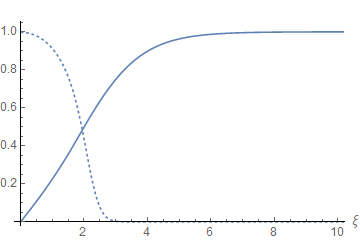
The competing orders are clearly shown in the profiles in Fig. 1 where one can see that the coherence lengths of both scalar fields are of the same order. This is a relevant property for condensed matter models that describe the quantum phase transition between a pure superconducting phase from one in which a competing order coexists with superconductivity. The result is a “halo” about the vortex core whose existence has been inferred from the charge-stripe order that has been found experimentally (see [10] and references therein).
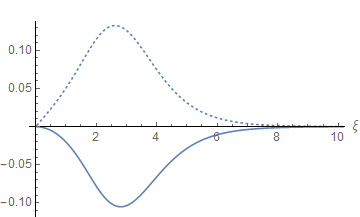
The electromagnetic field profiles in Fig. 2 are qualitatively similar to those in the pure CSH model. As it happens when a CS term is present, in addition to the magnetic filed, vortices are electrically charged and both fields should vanish at the origin where the Higgs field has to vanish to ensure regularity of the solution.
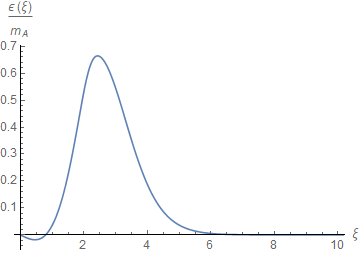
The energy density of the vortex solution as a function of the dimensionless radial coordinate is shown in Fig. 3. It is important to notice that at short distances the energy density is negative due to the fact that the potential is negative there and all other field contributions tend to zero when one approaches the origin. Because of this fact, when both orders are in competition, the total energy is lower than the energy of the pure CS-Higgs vortices. Indeed, in the latter case the BPS bound leads, for the minimal energy solution with topological charge [16] so that for the gauge coupling constant chosen in Fig. 3 the result is
| (40) |
while for the solution in which the competing field is present we get
| (41) |
Hence the presence of the competing field lowers the energy by . This phenomenon has been reported in many studies of the so called intertwined orders in high temperature superconductors (see [25] and references there) and more recently in a variational study of a phenomenological nonlinear sigma-model with two competing orders [26].
We have explored a wide range of parameter values. Fig. 4 shows the effect of changing the Higgs mass by changing with all other parameters fixed.

As the Higgs mass grows, the size of the vortex core decreases, as can be seen in Fig. 4 and also the field profile shrinks both in height and extension. We find that the same happens when one takes smaller and values in such a way that condition (15) and stability requirements hold.
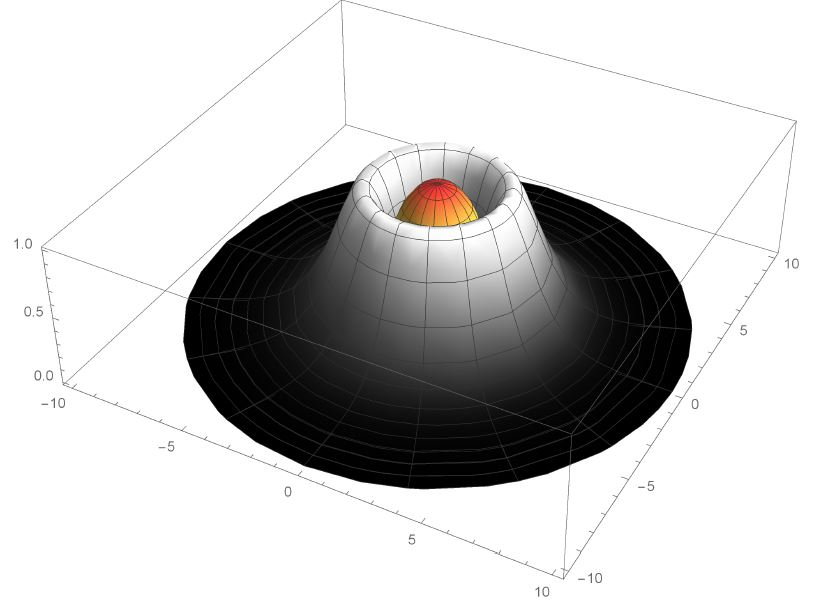
In Fig. 5 we have plotted the magnetic field and the field as a function of (). Note that in contrast with what happens for the Maxwell gauge dynamics, here the magnetic field does vanish at the origin so that the core of the vortex is not a disk but an annulus. The halo therefore was found to be inside the smaller radius circle, as was mentioned before.
The values in figures 1 to 5 were chosen because they lead to an enhanced value of . But in fact the region of competing orders was found for a wide range of parameter values.
Based on our numerical analysis of the solutions for different parameter ranges we present in Fig. 6 the three regions in which the competing scalar field solutions are trivial, purely CS vortex-like or they show a competition between two order parameters. We have chosen for the horizontal axis and studied the fate of the solutions when one changes the value of the coupling constant . We chose for the vertical axis because as it grows, the magnetic field contribution to the energy density also grows (see eq.(23)) so that the figure can be identified with the usual magnetic field versus control parameter diagrams.
In the region to the right of the dashed curve vortices are those of a CS-Higgs model as discussed in [16]: no competing order with the field takes place. To the left of the solid line no non-trivial vortex solutions exist. Solely in the region between the solid and dashed lines there is a competing order where the and fields are non-trivial and behave as in Fig. 1. As grows, the “halo” produced by the field about the vortex core reduces in size until no competing order is left. This is consistent with the definition of as , since a big value of would imply the Higgs field dominating over the competing field.
Fig. 6 can be interpreted at the light of the schematic zero temperature phase diagram of a layered superconductor in the presence of two order parameter proposed in reference [10]. To this end one can identify the two axes in their diagram, the magnetic induction and a control parameter , with and our parameter (note that when grows the contribution of the magnetic field to the energy density also grows).
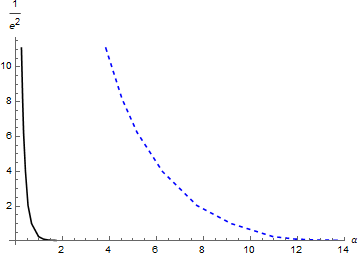
The crossover lines in the phase diagram of ref. [10] can be identified with the lines separating the three regions in figure 6 that we found without any approximation from the numerical solution of the coupled system of equations. It is also important to note that , the point at which the constant non-trivial solution for the competing scalar vanishes corresponds in ref. [10] to the point in which there is a continuous transition at between a pure superconducting phase and a phase with a coexisting orders. In contrast, because our potential has a larger number of parameters to fix, suitable choices allow to find solutions with coexisting orders both for , provided one is not too far from .
The figure also shows why equation (15) needs to be satisfied in order to have vortex solutions with a competing field halo. As grows the halo reduces in size until the condition is no longer satisfied and we are left with ordinary CS vortices to the right of the dashed line. Physically this means that the Higgs field is dominant with respect to the competing field and the latter becomes irrelevant. A similar effect occurs when grows and the RHS of condition (15) becomes larger, as can be seen from figure 4. Finally, we observed the same behavior when changing the value of , considering that a large implies a strong interaction between the fields and for small the competing orders decouple and again, no halo can be found.
Moving to smaller , condition (15) is easily satisfied and one would expect to still find vortex solutions with a competing halo. However, as mentioned before, there is another solution to the field equations playing a role in this region. This is the constant fields solution from eq. (39), valid for . This solution has a lower energy than the vortex configuration so it destabilizes the latter when one works with small values of . This argument provides a physical explanation to why numerically no vortex solutions were found at small values of the parameter . Note that topological stability does not in general guarantee that the solution cannot decay to a lower energy one. It happens, for example, in the case of the sigma model as a size instability. This also takes place in the decay of vortex solutions. Indeed, when the Landau parameter value is , the energy of a vortex with topological charge is larger than that of two vortices with , as it has been shown numerically [27].
6 Summary and discussion
In this work we have analyzed how the vortex-like solutions of an Chern-Simons-Higgs theory are affected when an uncharged scalar triplet is coupled to one of the Higgs scalars with a potential chosen so that develops a non-trivial vacuum state in the vortex core. As originally discussed in [5] this is a simple mechanism through which vortex strings can acquire non-Abelian moduli localized on their world sheets.
Models with two competing vacuum states are also of interest in studies of superconductivity phenomena and in this respect it is interesting to compare our results with the analysis of a layered superconductor in the vicinity of a quantum critical point separating a pure superconducting phase from a phase in which a competing order coexists with superconductivity [10]. The main results in that paper are summarized in the schematic zero temperature phase diagram that the authors propose which can be compared with the diagram presented in our Fig. 6.
Theories where two sectors with different field content are coupled through a potential like the one we employed here are also actively investigated in connection with cosmological problems like that of the fractional cosmic neutrinos [28] and the dark matter problem [29]. Their supersymmetric extension requires, apart from the (scalar-scalar) Higgs portal the addition of a kinetic gauge mixing [30]. As a result, coupling constants accommodate to the Bogomolnyi point for which the second order field equations can be reduced to the first order ones originally found in the study of the Ginzburg-Landau theory of superconductivity when the Landau parameter takes the value [31]. We expect in future work to extend the analysis of the present work in some of the directions described above.
Acknowledgements
F.A.S. would like to thank Eduardo Fradkin for useful and estimulating discussions. The work of F.A.S. is supported by CONICET grant PIP 608 and FONCYT grant PICT 2304. The work by G.T. is supported by the Fondecyt grant 11160010.
References
- [1] E. Witten, Nucl. Phys B249, 2971 (1985).
- [2] G. ’t Hooft, Nucl. Phys. B 138, 1 (1978).
- [3] J. Greensite, Lect. Notes Phys. 821, 1 (2011).
- [4] J. M. Cornwall and B. Yan, Phys. Rev. D 53, 4638 (1996)
- [5] M. Shifman, Phys. Rev. D 87, 025025 (2013).
- [6] S. Monin, M. Shifman and A. Yung, Phys. Rev. D 88, 025011 (2013); M. Shifman, G. Tallarita and A. Yung, Int. J. Mod. Phys. A 29, 1450062 (2014); A. J. Peterson and M. Shifman, Annals Phys. 348, 84 (2014); A. Peterson, M. Shifman and G. Tallarita, Annals Phys. 353, 48 (2014)
- [7] S.-C. Zhang, Science 275, 1089 (1997).
- [8] D. P. Arovas, A. J. Berlinsky, C. Kallin, and S.-C. Zhang, Phys. Rev. Lett. 79, 2871 1997.
- [9] For a more complete list of references see S. Sachdev, Quantum Phase Transitions, Cambridge University Press, Cambridge, 1999).
- [10] S. A. Kivelson, Dung-Hai Lee, E. Fradkin and V. Oganesyan, Phys. Rev. B 66, 144516 (2002).
- [11] S. Yan, D. Iaia, E. Morosan, E. Fradkin, P. Abbamonte and V. Madhavan. Phys. Rev. Lett. 118, 106405 (2017)
- [12] S. K. Paul and A. Khare, Phys. Lett. B 171 (1986) 244.
- [13] H. J. de Vega and F. A. Schaposnik, Phys. Rev. Lett. 56, 2564 (1986); Phys. Rev. D 34, 3206 (1986).
- [14] J. Hong, Y. Kim and P. Y. Pac, Phys. Rev. Lett. 64 (1990) 2230.
- [15] R. Jackiw and E. J. Weinberg, Phys. Rev. Lett. 64 (1990) 2234; R. Jackiw, K. M. Lee and E. J. Weinberg, Phys. Rev. D 42 (1990) 3488.
- [16] L. F. Cugliandolo, G. Lozano, M. V. Manias and F. A. Schaposnik, Mod. Phys. Lett. A 6, 479 (1991).
- [17] H. Weigel, M. Quandt and N. Graham, Phys. Rev. Lett. 106, 101601 (2011)
- [18] S. Deser, R. Jackiw and S. Templeton, Phys. Rev. Lett. 48, 975 (1982); S. Deser, R. Jackiw and S. Templeton, Annals Phys. 140, 372 (1982) [Annals Phys. 281, 409 (2000)]
- [19] H. J. De Vega and F. A. Schaposnik, Phys. Rev. Lett. 59, 378 (1987).
- [20] L. F. Cugliandolo, G. Lozano and F. A. Schaposnik, Phys. Rev. D 40, 3440 (1989).
- [21] E. Witten and D. I. Olive, Phys. Lett. 78B, 97 (1978).
- [22] P. Arias, E. Ireson, F. A. Schaposnik and G. Tallarita, Phys. Lett. B 749, 368 (2015)
- [23] E. Ireson, F. A. Schaposnik and G. Tallarita, Int. J. Mod. Phys. A 31, 1650178 (2016)
- [24] M. Shifman and A. Yung, Phys. Rev. Lett. 110, no. 20, 201602 (2013) doi:10.1103/PhysRevLett.110.201602 [arXiv:1303.7010 [hep-th]].
- [25] E. Fradkin, S. Kivelson and J. Tranqueda, Rev Mod. Phys. 87 2015.
- [26] Yuxuan Wang et al, arXiv:1802.01582.
- [27] N. Manton and P. Sutcliffe, “Topological Solitons", Cambridge University Press, Cambridge (2010); L. Jacobs and C. Rebbi, Phys. Rev. B 19 4486, (1979).
- [28] S. Weinberg, Phys. Rev. Lett. 110, no. 24, 241301 (2013).
- [29] P. Arias, D. Cadamuro, M. Goodsell, J. Jaeckel, J. Redondo and A. Ringwald, JCAP 1206, 013 (2012).
- [30] P. Arias, E. Ireson, C. Núñez and F. Schaposnik, JHEP 1502, 156 (2015).
- [31] J. L. Harden and V. Arp, Cryogenics 3 (1963) 105.